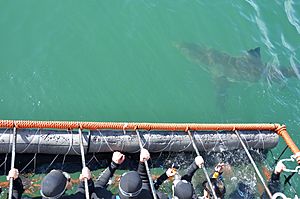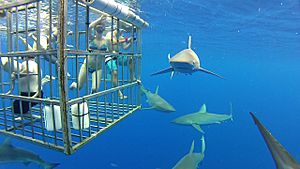Shark cage diving facts for kids
Shark cage diving is a cool way to see sharks up close while staying safe inside a strong cage. It's like snorkeling or diving, but with a protective barrier between you and the sharks. People use these cages for different reasons: to study sharks, to film them for movies, or just for fun as a tourist activity. Sometimes, people use bait (like fish pieces) to attract sharks closer to the cage. This is called chumming. Some people think chumming might change how sharks naturally behave, which has led to some discussions.
These special cages are also used to keep divers safe when they are working in waters where dangerous sharks live. Divers might use the cage as a safe spot to rest, or as a way to go down into the water and come back up slowly. This is especially helpful when divers need to stop at certain depths for a while to let their bodies adjust to the pressure. Sometimes, divers even carry smaller, mobile cages with them when they are collecting things like abalone (a type of sea snail).
What is a Shark-Proof Cage?

A shark-proof cage is a strong metal box that divers use. It helps them watch dangerous sharks very closely but still be safe. Many different kinds of sharks can be seen, but the most common ones people see from a cage are the great white shark and the bull shark. These sharks can sometimes be aggressive.
Shark-proof cages are built to be super tough. They can handle sharks bumping into them or even trying to bite them. Their main job is to protect the people inside from getting hurt. These cages also help scare sharks away just by being there. Cage diving lets people watch sharks for science, for business, or just for fun. Sometimes, people can even interact with the sharks from inside the cage.
Shark Cage Diving for Tourists
In the 2000s, shark cage diving became a very popular activity for tourists. For example, in South Australia, people take boats from Port Lincoln to the Neptune Islands. There, they can see great white sharks. They can either watch from a cage tied to the back of the boat near the surface, or from a cage lowered all the way to the bottom of the sea. This activity is a big deal for tourism in South Australia.
Shark cage diving is also very popular near the Guadalupe Island Biosphere Reserve in the Pacific Ocean, off the coast of Mexico.
Attracting Sharks with Bait
One way to make sure tourists see sharks is by using bait. This is called chumming. Tour guides put fish or other things that sharks like into the water. Tourists stay inside the safe cage while the bait attracts sharks for them to watch.
However, some people worry that using bait might make sharks act differently. Some groups who care about nature, as well as many scuba divers and photographers, think this practice is not good and could even be dangerous.
For example, in South Australia, some divers who collect abalone have been attacked by great white sharks. These divers believe that shark cage diving tourism has changed how sharks behave. They think sharks are now more likely to come close to boats. One abalone diver, Peter Stephenson, even asked for shark cage diving to be stopped. He said it was making his job more dangerous. But the government of South Australia says there is "no scientific evidence" that shark cage tourism makes it more likely for people to be attacked by sharks.
People who are against the cage-diving industry, like shark-survivor Craig Bovim, believe that using bait over and over again to attract sharks might change their behavior. However, others, like marine environmentalist Wilfred Chivell, argue that there is no clear link between baiting sharks and shark attacks on humans. Still, there is some proof that baiting sharks for tourism does change how Great White Sharks move around.



